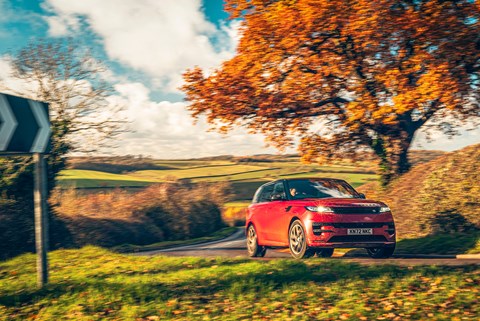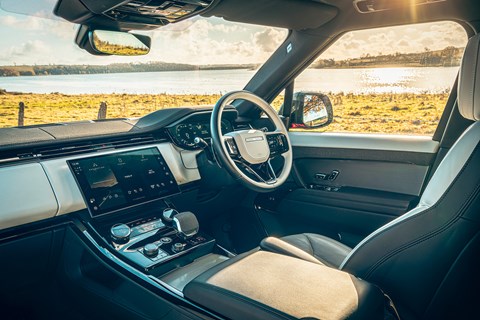► We live with a Range Rover Sport
► Range Rover Sport D300 SE long-term test
► Month 1 of our daily driver diaries
Despite all the talk of improved batteries and various manufacturers, including Mercedes and Nio, topping 1000km, or 620 miles, on a charge, there is still only one fuel for mega miles currently – diesel. When this Range Rover Sport D300 turned up, the tank’s range was showing as 604 miles and it’s subsequently been a consist- ently weird feeling within our EV-dominated world knowing that no matter what the journey, this retro-fuelled car is simply going to monster it. Minimal planning, jump in, go.
Don’t get me wrong – my previous long-term test car, the Porsche Taycan GTS, never gave me any bother with range or charging anxiety, but it’s still quite something to know that you’ve got the Rangie’s effortless endurance potential nestled under your right foot. You knew the Porsche could do it but it required a little bit of faith, a niggle of thought process before any long journey. In the Rangie, distances literally never cross your mind.
There’s also another bonus of plumping for a Range Rover Sport filled from the black pump: the waiting times are much, much shorter. And I mean by a margin of years, not weeks or months. A plug-in Sport might take a couple of years to come through (at the outer limit) but a diesel can be with you in three to six months. I know the chips crisis is easing, but it’s still not a universal truth that all cars are easy to come by all the time.
So we find ourselves with the prospect of an effortless six months ahead. To me, the Sport is the forgotten Land Rover (along with the Range Rover Velar), when all the talk is of the posh full-fat Rangie or the phoenix-like Defender. Even the perennially awkward Disco 5 gets plenty of airtime, albeit not always the most flattering. It’ll be interesting to find out if there’s still a space for our car within the line-up – can it marry the Range Rover’s luxe with a bit more everyday usability and less ostentatious associations of Mayfair and richer-than-yow vibes?
If subtlety is what you’re aiming for, I’d suggest you swerve the Firenze Red paint (£895), contrast roof (£950), white leather interior (‘light cloud’ in the brochure, very much ‘white’), 22-inch SV Bespoke wheels (£1600) and Black Exterior pack (£1450). It all looks good in the images here but is a bit much on a wintry A43 outside Corby.

At least Land Rover offers plenty of paint colours, though. There are 25 to choose from and you can spend up to a frightening £9900 if you so desire – my money would go on Giola Green for £895.
The only other options fitted to this base-spec SE model are front foglights (£140), towbar (£1130), loadspace floor partition (£285), SV bespoke carpet mats (£300) and privacy glass (£475), but you don’t feel short-changed driving it. It does make you realise that there’s such a thing as too much choice – are illuminated metal treadplates with Range Rover script (£655) really going to transform my life? Unlikely. With Apple CarPlay, a heated steering wheel and the excellent Pivi Pro 13- inch touchscreen, most of the necessary boxes are ticked.
The 20-way electric front seats are supremely comfortable, with just the right amount of under-thigh support, and it also comes as standard with heated and electric rear seats. I must admit I struggle to see the point of power-fold rear seats – how hard is it to flick a lever? – but more and more cars come with this so the demand must be out there. Think of the weight, though.

Our car, which arrived with 13,410 miles on the clock, is the base diesel. The engine is BMW’s straight-six 3.0-litre so it’s wonderfully smooth – long gone are the days of diesel clatter with modern motors like this – but it’s not the punchiest. Outputs of 296bhp and 479lb ft are fair enough figures, but the Sport weighs 2.4 tonnes so its pace is adequate rather than sporty. Certainly a diesel BMW X5 accelerates a deal smarter. A Sport D350 is also available but it’s another £17,300 so needs to be transformative.
But my god the RRS rides well on its standard air suspension, impressively not getting flustered even if a wheel drops into a pothole, normally a weakness on air-sprung cars. A Range Rover is lovely and cosseting, but the Sport takes that brilliant damping and brings the car to you a bit more so it’s less isolating than the big brother.
I mean that in a good way – while the Range Rover floats you above the road, the Sport puts you on it, which I prefer. It’s still supremely comfortable but more connected.
The ride is definitely the thing that hits home first, but there have been a couple of occasions when the chassis has dealt so brilliantly with a corner that I’m looking forward to a planned journey involving lots of twisties and few straights. It’ll also be a long way away.
Logbook: Range Rover Sport D300 SE
Price: £83,620 (£90,845 as tested)
Performance: 2997cc turbodiesel six-cylinder, 296bhp, 6.6sec 0-62mph, 135mph
Efficiency: 36.9mpg (official), 30.1mpg (tested), 200g/km CO2
Energy cost: 23.1p per mile
Miles this month: 1892
Total miles: 15,302